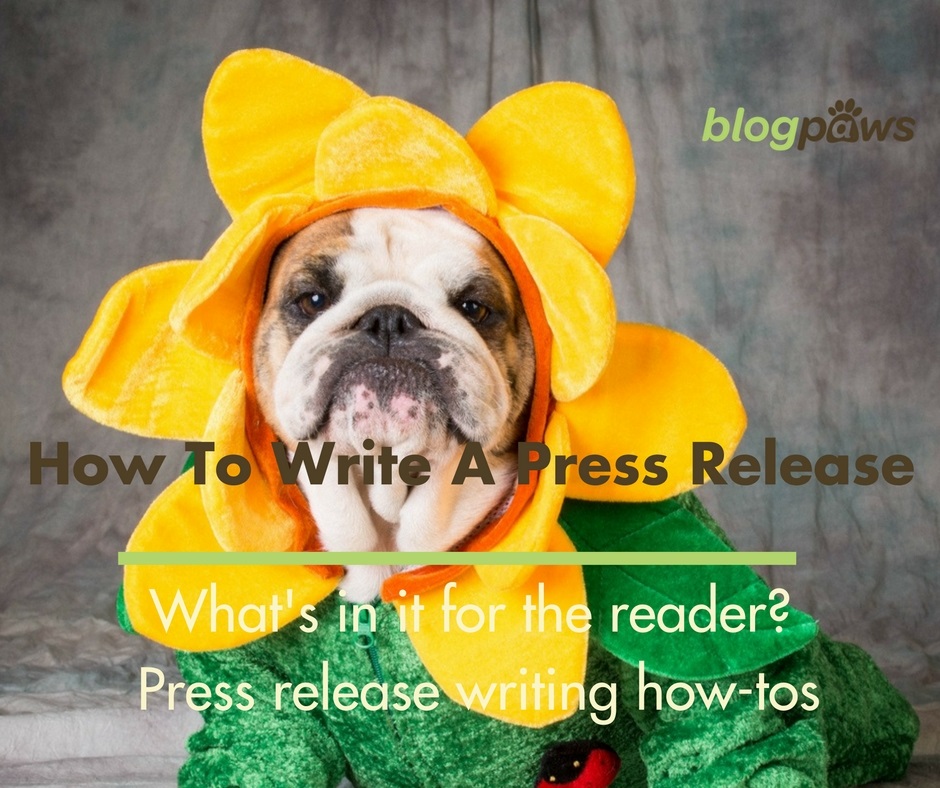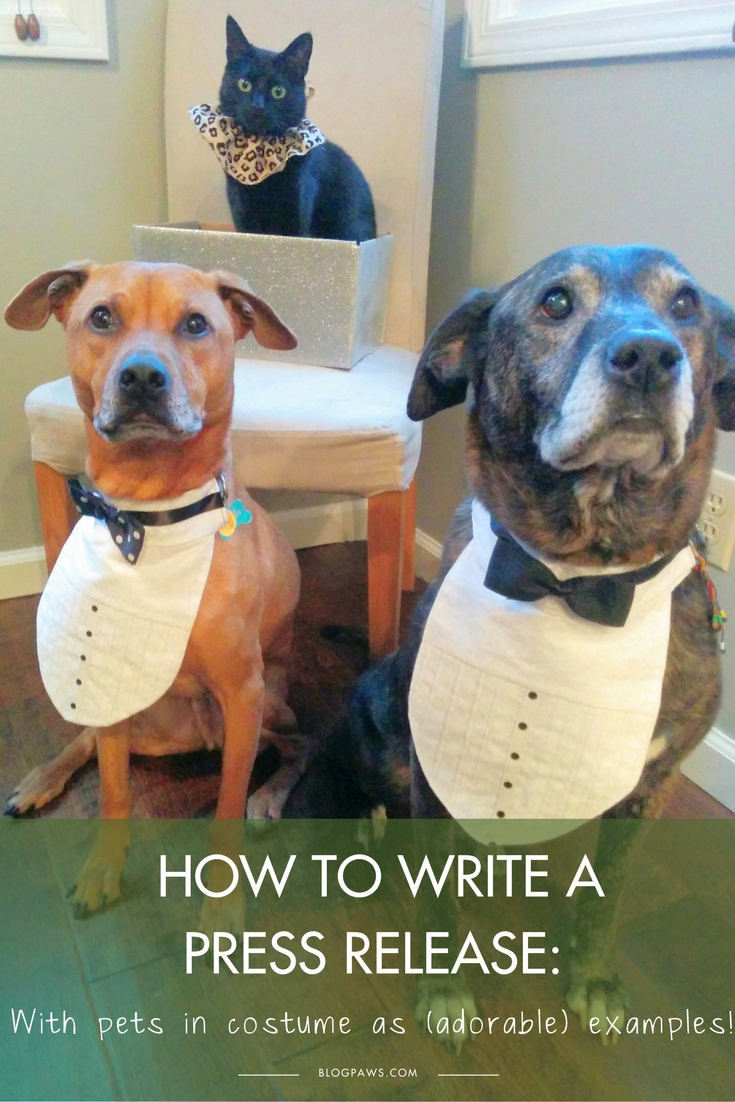Freelancing 101: How To Write A Press Release
Last week I wrote about the top five reasons to write a press release. This week we will dig into the nitty gritty of how to write a press release.
As a former journalist and editor of a local newspaper, and as a former public relations director for a local hospital, I have been on both the submitting end and the receiving end of press releases. Just as when you write a query, you need to direct it to a specific person, so too, do you need to do that when you’re submitting a press release–especially when it’s about yourself or your pet business, or to get yourself known as an expert in your field.
A press release about you and your pet business is a great way to get known in your niche and for your particular area of expertise. Remember, though, no reporter wants to hear a pitch that is “all about you” that offers no substance to the reader. With that in mind, let’s move onto the “hows” of writing a press release.
What’s in it for the reader?
Journalists are typically hungry for a good story, good angle, or new angle on a story. Let’s take Halloween for our example in this post. Halloween is more than a month away, and if you’re targeting a press release to a local newspaper, chances are you may stand a chance to get published. If you’re targeting a magazine, you are woefully late in your submission at this time. Okay… Halloween is coming up. What can you, as a pet blogger, write about for Halloween? Here are a few potential topics:
- Dressing your pet for Halloween
- Making costumes for your pet
- Halloween dangers for your pet
- Keeping children safe on Halloween around pets
- Cat safety on Halloween
If any of those topics are something you’d cover on your blog, then you should consider writing a press release about it. Let’s choose: “Halloween dangers for your pet” as the topic for the press release. This is a topic about which you can not only write, but it is something that the readership of the newspaper would want to be aware of.
Keep in mind, you’re pitching this story idea to the journalist, but you’re also subtly showing him or her that you are the go-to expert on this particular topic, and your bio at the bottom of the release will point the journalist back to your blog. You’ve offered great information to the readership AND you’ve also been able to promote your blog. Pretty neat, right? You’re not having to reach out and say, “Hey, I’m out here. Read my blog!” You’re offering valuable information that will naturally lead them back to you.

Laser-focused targeting
Just as you wouldn’t write a query letter and direct it “To whom it may concern,” you need to target your press release toward a specific reporter, department, or editor. The way you know to whom to direct your press release is by researching the publication. Don’t send a “Halloween dangers for your pet” to the business editor. Don’t send a “How to make costumes for your pet” to the food journalist.
Pick up the paper. Read the online issues. Research and find out who would be best served by receiving a press release on “Halloween dangers for your pet.” Is there a lifestyle editor? Is there an editor responsible for family-friendly content? Is the paper so small (like the ones in my hometown) that they have reporters that cover specific geographic areas? Even though a “Halloween dangers for your pet” press release would be valuable information for any geographic region, reach out to the journalist who covers the area in which you live. Make a connection with that journalist by helping spark a story idea through the submission of your press release.
Believe me, even though the newspaper I worked at was very small, if you sent a press release to the sports editor that wasn’t sports-related, he would toss it or delete it, and the appropriate reporters would never know it was received. That may not be the case in all newspapers, but don’t take a chance on your press release getting tossed simply because you didn’t do the research to find out to whom to submit the release.
Understand how to write a press release
A press release isn’t a blog post. A press release tells a story. It follows “the reverse pyramid structure.” This means you begin the press release with a broad introduction: “Halloween is fast approaching and it can be one of the most dangerous times of year for your readers’ beloved pets…” In that one sentence you’re offering a “hook,” stating an upcoming event, showing why the readership might care.
- After you’ve delivered this “topic sentence” you can go into specifics. “Here are the five biggest dangers to pets on Halloween along with five ways to keep them safe.” Now you’re offering information on the problem as well as solutions.
- Once you’ve completed sharing the information you promised in the headline of the story, you wrap up the press release with a call to action, “You can reach me, Pet Blogger In Your Area, to discuss more in depth ways in which your readers can protect their pets during this potentially frightening night.” Give your phone number, email address, mailing address.
- Let the journalist know whether you have photos they could use if they decide to run the press release. Email a headshot of yourself with your press release. Let the journalist put a face with the name.
- When you submit your press release, put your name and contact information at the top. Add in the date that you’re submitting it. Direct it to a specific journalist/publication. Add in the line “FOR IMMEDIATE RELEASE.”
- Craft a catchy headline. Just as you take time to write the perfect headline for your blog, you need to put that type of care into your press release’s headline.
- Let the reporter know you will be following up by phone in X number of days. Put that date on your calendar and make certain you do follow up.
- At the end of the press release put either -END- or ### (this is a journalistic style that lets the reporter know they’ve come to the end of your release). Under the hashtags, write a killer bio for yourself. Add in your geographic location, any awards you’ve won, how long you’ve been blogging, the types of pets you have, anything else you believe is relevant that sets you up as the expert for this particular press release. I always put my bio on italics as another way to set that apart from the content itself.
Grammar matters
Even though I shouldn’t have to say this, I will. Because you want to be seen as the expert in the topic for which you’re submitting a press release, you need to submit an error-free and grammatically-correct press release.
Check the spelling of the reporter’s name. Read and re-read your press release before you hit send. Once they receive it you won’t be able to send another just because you need to fix an error. The reporter will see you as a flake, and your credibility as an “expert” on the topic about which you’re writing will be tarnished.
If you’re shaky on grammar, spelling and punctuation, ask a friend to read the release before you submit it.
Be prepared to market your release
You may be submitting your press release to the local newspaper that has a readership of only a few thousand, but if it’s picked up, you need to be prepared to market your inclusion. Be aware that the reporter might just run your press release with a few tweaks without even reaching out to you. An ethical journalist will give you credit for the piece, and your name should appear as the source for the information. There have been times I’ve submitted a press release, then lo and behold, the reporter printed essentially the same information under his byline with no mention of me. I did call the editor and point that out. There was no retraction or attribution offered after the fact, but I did want them to know it was very “curious timing.”
If your press release is printed and you’re mentioned, you should share that information on your blog and link back to the newspaper. Share it on your social media and tag the newspaper’s social pages in your mention.
Reach out to the reporter and thank him or her for printing your information. Build that relationship.
Other news outlets
I’ve written mostly about the pet blogger connecting with the local newspaper, but there are myriad other sources to which to submit a press release. There are online pet news-centric magazines, which may be interested in your press release. If you’re a member of a trade group that has a newsletter that goes out to the membership, they may want to see your press release. There are paid outlets and there are free online outlets to which you can submit a press release.
If you’re submitting a press release like “Halloween dangers for your pet” that is a topic with wide appeal. This means you don’t have to stop with your local newspaper. Look for online outlets. Seek magazines that might want your information. Think outside the box. Sure, a pet-centric outlet might be interested, but a shelter that provides a newsletter to pet parents could be a great spot to submit. Parenting magazines just might want let their readers know how to keep pets safe on Halloween, especially if you can tie it into safety for the child in the household as well.
Brainstorm where you could submit your press release. Don’t limit yourself to the local newspaper. Think big! If, however, you’re nervous about promoting yourself, start local, build momentum then shoot for the stars!
Action item
Take some time, right now, while this information is fresh in your mind and brainstorm topics about which you could write a press release. Write it. Submit it. Let me know if you were successful! All of us pet bloggers are in it together so let’s support one another in our media efforts!
Robbi Hess is an award-winning author, full-time writer and time-management guru. She works with bloggers and solopreneurs and blogs at All Words Matter.


